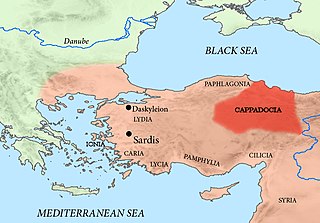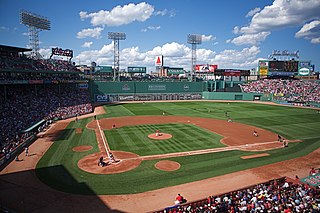
In classical mythology, Hermanubis was a god who combined Hermes with Anubis. He is the son of Set and Nephthys.

A Dictionary of Greek and Roman Antiquities is an English language encyclopedia first published in 1842. The second, improved and enlarged, edition appeared in 1848, and there were many revised editions up to 1890. The encyclopedia covered law, religion, architecture, warfare, daily life, and similar subjects primarily from the standpoint of a classicist. It was one of a series of reference works on classical antiquity by William Smith, the others cover persons and places. It runs to well over a million words in any edition, and all editions are now in the public domain.

Ariamnes I was satrap of Cappadocia under Persian suzerainty. Son of Datames and father of Ariarathes I and his brother Orophernes (Holophernes), Diodorus states that Ariamnes governed fifty years although it is unclear how this could be correct given the dates that his father Datames and his son Ariarathes I were satraps of Cappadocia.

The Dictionary of Greek and Roman Geography, first published in 1854, was the last of a series of classical dictionaries edited by the English scholar William Smith (1813–1893), which included as sister works A Dictionary of Greek and Roman Antiquities and the Dictionary of Greek and Roman Biography and Mythology. As declared by Smith in the Preface: "The Dictionary of Geography ... is designed mainly to illustrate the Greek and Roman writers, and to enable a diligent student to read them in the most profitable manner". The book stays up to the description: in two massive volumes the dictionary provides detailed coverage of all the important countries, regions, towns, cities, geographical features that occur in Greek and Roman literature, without forgetting those mentioned solely in the Bible. The work was last reissued in 2005.
Antigenes was a general of Alexander the Great, who also served under Philip II of Macedon, and lost an eye at the siege of Perinthus. After the death of Alexander in 323 he obtained the satrapy of Susiana. He was one of the commanders of the Argyraspides and, with his troops, took the side of Eumenes. On the defeat of Eumenes in 316, Antigenes fell into the hands of his enemy Antigonus, and was burnt alive by him.
Acanthus the Lacedaemonian, was the victor in two footrace events, the diaulos (δίαυλος) and dolichos (δόλιχος), in the Olympic Games of 720 BC. He was also, according to some accounts, the first who ran naked in these games. Other accounts ascribe this to Orsippus the Megarian. Thucydides says that the Lacedaemonians were the first who contended naked in gymnastic games, although he does not mention Acanthus by name.
Anaxandra was an ancient Greek female artist and painter from Greece. She was the daughter and student of Nealkes, a painter of mythological and genre scenes. She painted circa 228 B.C. She is mentioned by Clement of Alexandria, the 2nd century Christian theologian, in a section of his Stromateis (Miscellanies) entitled "Women as Well as Men Capable of Perfection". Clement cites a lost work of the Hellenistic scholar Didymus Chalcenterus as his source.
In Greek mythology, Acratopotes, the drinker of unmixed wine, was a hero worshiped in Munychia in Attica. According to Pausanias, who calls him simply Acratus, he was one of the divine companions of Dionysus, who was worshiped at Attica. Pausanias saw his image at Athens in the house of Polytion, where it was fixed in the wall.
Aetna was in Greek and Roman mythology a Sicilian nymph and, according to Alcimus, a daughter of Uranus and Gaia, or of Briareus. Stephanus of Byzantium says that according to one account Aetna was a daughter of Oceanus. Simonides said that she had acted as arbitrator between Hephaestus and Demeter respecting the possession of Sicily. By Zeus or Hephaestus she became the mother of the Palici. Mount Aetna in Sicily was believed to have derived its name from her, and under it Zeus buried Typhon, Enceladus, or Briareus. The mountain itself was believed to be the place in which Hephaestus and the Cyclops made the thunderbolts for Zeus.
Sangarius was a Phrygian river-god of Greek mythology. He is described as the son of Oceanus and Tethys and as the husband of Metope, by whom he became the father of Hecuba. He is also the father of Nana and therefore the grandfather of Attis. The Sakarya River itself is said to have derived its name from one Sangas, who had offended Rhea and was punished by her by being changed into water.
Alcimenes can refer to a number of people in Greek mythology and history:
Neleides was a patronymic of ancient Greece derived from Neleus, son of the Greek god Poseidon, and was used to refer to his descendants. In literature, this name typically designated either Nestor, the son of Neleus, or Antilochus, his grandson. One notable offshoot of this family line was the Alcmaeonidae.
Aleuas or Alevas can refer to more than one person from ancient Greek myth and history:
Almo was in ancient Roman religion the eponymous god of the small river Almo in the vicinity of Rome. Like Tiberinus and others, he was prayed to by the augurs of Rome. In the water of Almo the aniconic stone embodying the mother of the gods, Cybele, used to be washed. He had a naiad daughter named Larunda.
The gens Herminia was an ancient patrician house at Rome. Members of the gens appear during the first war between the Roman Republic and the Etruscans, circa 508 BC, and from then to 448 BC. Two members of the family held the consulship, Titus Herminius Aquilinus in 506 BC, and Lars Herminius Aquilinus in 448.
Ambryon was an ancient Greek writer who wrote a work on the poet Theocritus, from which Diogenes Laërtius quotes an epigram of Theocritus against Aristotle. His date can only be fixed between the 3rd century BC and the 3rd century AD, and his work itself, On Theocritus, is no longer extant.

Pegasides were nymphs of Greek mythology connected with wells and springs, specifically those that the mythical horse Pegasus created by striking the ground with his hooves.
Archelaus was a geographer of ancient Greece who wrote a work in which he described all the countries which Alexander the Great had traversed.









